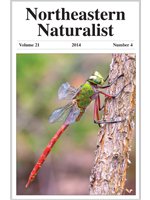The overall objective of this field study was to determine if Pinus nigra (Austrian Pine) could serve as a useful biomonitor to evaluate multi-year concentrations of total mercury (tHg) in vegetation within southwestern Pennsylvania. Austrian Pine has been widely planted as an ornamental, and formerly as a Christmas tree, and is now naturalized within the region. We collected needle samples annually during October 2004–2010 at 15–21 locations within a 5000-km2 study area. Because Austrian Pine trees typically retain needles for 3 years, we collected samples from 3 needle-age groups: current year (∼0.5 y old in October), previous year (∼1.5 y old), and third-year (∼2.5 y old), and analyzed them for total mercury (tHg). Across all years and plots, mean tHg concentrations among the 3 needle ages were significantly (P < 0.05) different from each other. Mean tHg concentration was greatest in the 2.5-yr-old needles (25.9 ± 3.4 ng/g), less in 1.5-yr-old needles (20.2 ± 3.2 ng/g), and least in the 0.5-yr-old needles (11.3 ± 2.3 ng/g). The greatest mean tHg content in the oldest needles indicates that Austrian Pine may sequester atmospheric Hg in/on its needles. Although the tHg concentrations within all 3 needle ages declined slightly during 2004–2010, downward linear trends were not significant, possibly due to the short sampling period (7 years). Needle tHg concentrations were significantly less in the northeastern portion of the study area, located farthest downwind from industrial sources of tHg, and may represent background tHg levels for conifers in the region. Results from this study suggest that any biomonitoring program involving conifers should consider needle age when developing sampling protocols. In addition, results suggest that abscised older pine needles may contribute substantially to the tHg soil burden beneath conifer stands. This is the first report from North America regarding tHg concentrations in/on various-aged Austrian Pine needles. Austrian Pine may prove useful as a biomonitor when evaluating spatiotemporal patterns of tHg accumulation within vegetation in eastern North America.
How to translate text using browser tools
1 December 2014
Mercury Accumulation in Pinus nigra (Austrian Pine)
Russell J. Hutnik,
James R. McClenahen,
Robert P. Long,
Donald D. Davis
ACCESS THE FULL ARTICLE

Northeastern Naturalist
Vol. 21 • No. 4
December 2014
Vol. 21 • No. 4
December 2014




